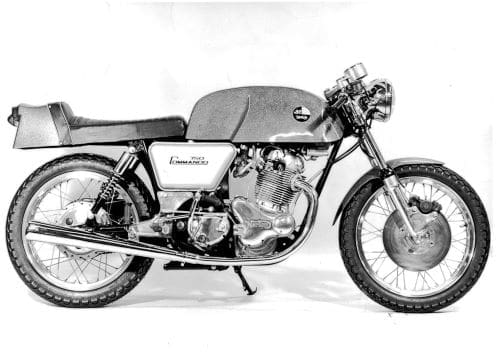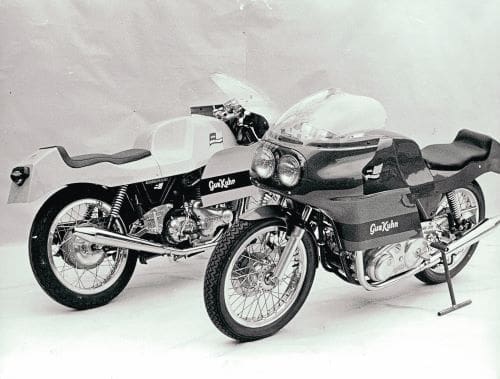Gus Kuhn was a speedway rider and TT racer, and competed in most other two-wheel sports. He also ran his own shop, but will always be best known for a bike he never saw – the Gus Kuhn Commando.
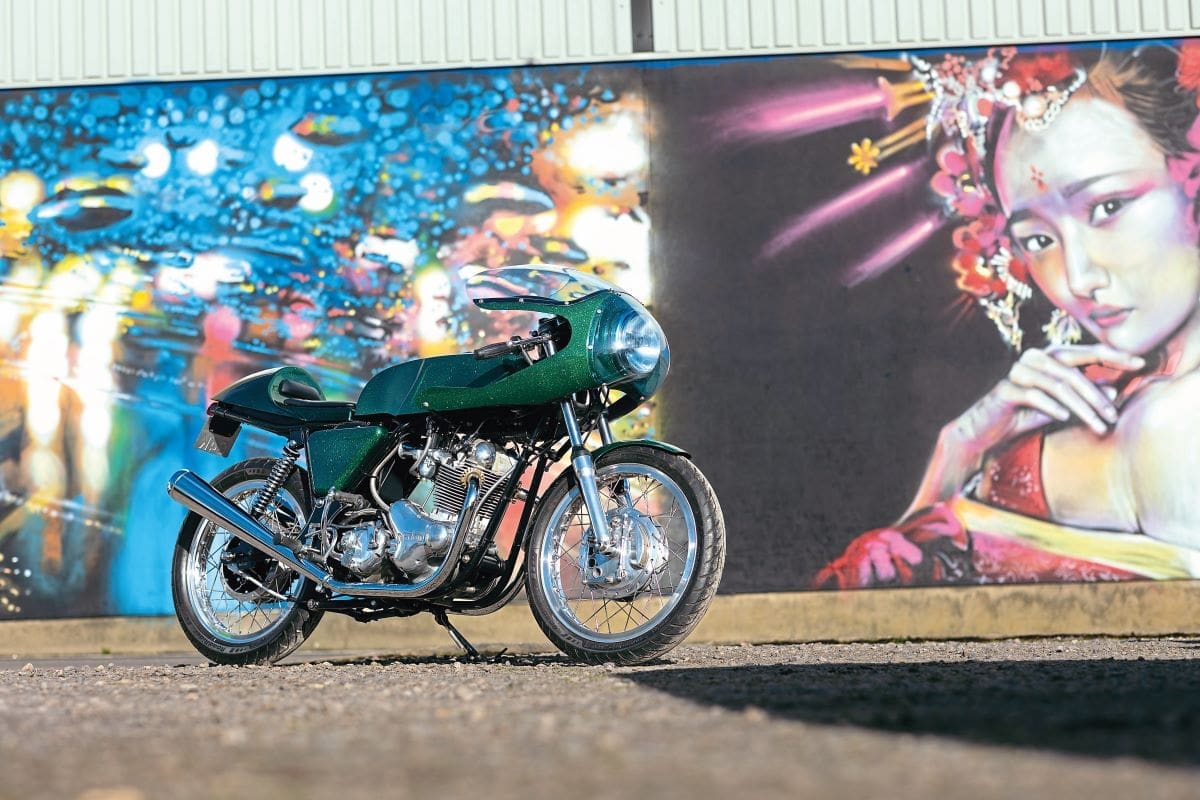
Words by Oli ‘Two Hats’ Hulme Photography by Gary ‘Look At My New Camera’ Chapman
Shelagh and Ronnie Moore build amazing Norton-based specials. Tritons, ES2-based café racers, sporty Commandos and all manner of marvellous Bracebridge Street-born creations have graced their shed. At one point the couple were considering relocating to France to build the café racers that the Gallic biker seems to love so much. Even now buyers will happily wait for years for one of their creations to cross the channel.
Both are long-term motorcyclists. As a teenager, Shelagh was too young to compete on the track so she borrowed her older sister’s identity to get a sidecar racing licence and would travel hundreds of miles across country to Snetterton to be a passenger in a racing outfit. Ronnie was a member of the famous 59 Club in 1962: “I used to go to the club house in Hackney, with a Norman Nippy, at first, but I quickly went on to a Matchless G2.”
The Gus Kuhn Commando 750 was found by Shelagh. “I was buying frames and stuff to turn into specials. Ronnie would come home and I’d tell him, ‘I’ve bought another frame’.”

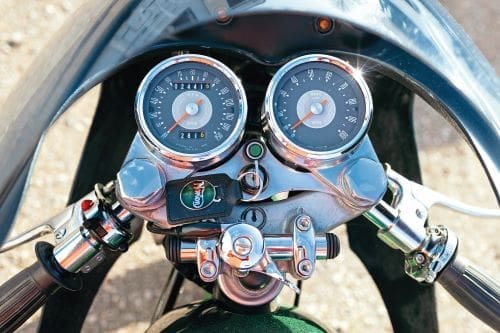
It didn’t always work out – one splendidly repainted Featherbed frame was bought from “two blokes in London.” Although it had a well-painted black frame, Shelagh wanted it red so she sent it off to be shotblasted, only to discover great chunks of the frame had rotted away and the holes filled with lead.
They were more successful when they bought the Gus Kuhn Commando in boxes. “To be honest most of it was rusty and a lot had been butchered,” says Ronnie.
Wheels and brakes
“We had the rims built by Devon Rim Co. with stainless spokes. When checking, we found the front hub was oval, so it would have to be skimmed. This was done by Hamlin’s of Bridgwater, which said it had taken so much off the hub it was within an inch of its life.”
When fitting the brake plate there was a danger that the twin leading shoes would go over the cam when braking. Some effort was made to pack out the cams, but Ronnie says: “This was bordering on bodging, so we sent the shoes off to the very helpful Custom Brakes and Hydraulics in Sheffield for double thickness pads to be fitted. On return they put the wheel onto a vice, placed the brake shoes into the brake plates, and sandpapered the shoes down until the whole brake plate slotted down into the drum.”
It worked perfectly after some fettling, with lots of spare adjustment on the cable. The rear drum needed no attention.
The engine
A Peter Williams PW3 camshaft was fitted to “give it that extra bit of stick.” At the same time the existing followers (that were in good condition) were used after having the faces reground. The camshaft breather on the left-hand side crankcase was removed and the now-redundant threaded hole was filled with a Velocette kick-start spring retaining bolt. To give the engine better breathing, the timing side case was drilled as per the Norton Service Notes. Ronnie swears by the information contained in the notes: “Anyone considering doing engine work on Commando engines should be getting this from the Norton Owners Club. It has a wealth of information and updates to help you on your way.”
New Superblend bearings were fitted to the cases, at the same time polishing out any blemishes in the inside the cases. “We had the crank balanced by the late Mike Hemmings, who did a superb job. He had to add tungsten to the crank to make it run smoothly. It’s as smooth as anything.”
There was a rebore and new pistons, the valve seats were recut, and the head fitted with new valves and springs. The signature Gus Kuhn engraving was recreated on the inside of the timing case.
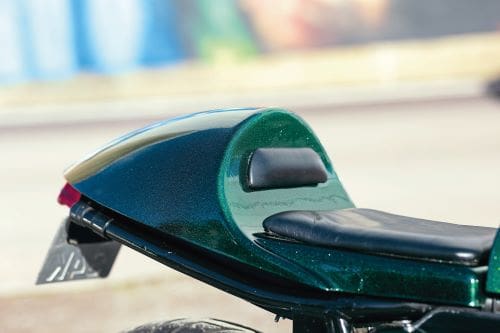
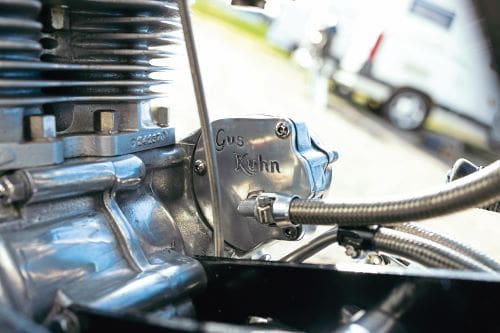
Controls and bodywork
The original Kuhn Commandos might have been brilliantly engineered, but it has to be said that the original bikes lack a little… aesthetic charm. The expression ‘only a mother could love it’ springs to mind. The original and very hefty Gus Kuhn silencer/rearset plate could not be saved from the boxes: “I suppose we were to expect it on a 40-year-old box of bits.”
Those silencer plates being junked, Shelagh and Ronnie decided they would have been too heavy-looking anyway: “We designed our own style plates with an engraved inner line which took days to achieve.” To paint the plates and leave the inner line exposed took a lot of thought as it was impossible to mask it off in the conventional fashion, until one night after working on a couple of bottles of wine, they came up with a solution. Ronnie had a brainwave and filled the inner line with Blu Tack and sprayed over it, peeling away the tack once the paint was dry and leaving a perfect finish.
The silencers are Dunstalls, bought from Chris Knight Motorcycles in France. “We found that they were stuffed inside with so much cotton wool for silencers that Boots Pharmacy would have been jealous.” The wadding was removed to give the silencers their original bark and everything was fitted with rubber-backed washers in case of any faint vibration, though there wasn’t any.
Shelagh got the fairing screen and headlamp bubble from eBay, and it may be a Rickman item. The seat and tank were sourced from the USA and are a lot prettier than the Kuhn originals. The tank is 100% ethanol proof. It has a gel liner, and Ronnie says the work is done far above the UK standard. “It was already expensive enough, but the import duty was horrendous.” Tank, seat, and fairing were finished in original Fireflake green, and Shelagh spent hours on the web getting the correct metallic grade. It was applied by the now sadly passed away ace sprayer, Larry Erickson.

Frame and lines
To fine-tune the look, the loop at the rear of the frame was cut off and the remaining tubes were bent upwards to give the seat a downwards look, in line with the slant of the engine.
That attention to the lines extended to the engine casings: “We wanted something else eye-catching and different, so we drilled out the clutch casing and inserted stainless steel gauze. Getting this to be positioned with the lines on the gauze at the same angle as the seat and the forward-facing Commando engine, with everything flowing downwards to the front was a headache, but it was achieved.”
The Mick Hemming belt drive clutch can now be seen through the gauze and gives the striking effect they wanted, especially with the engine running.
The gearbox didn’t need any work, but they replaced the gearbox layshaft bearing anyway.

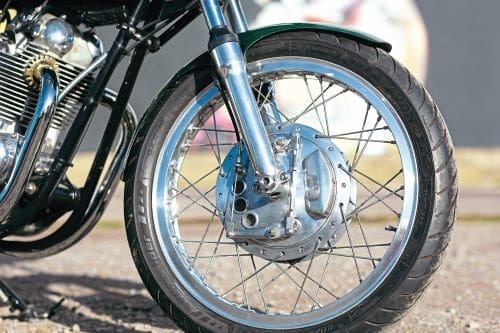
Would you like to own one?
Building the Commando from the ground up took around eight years on and off, as it was pushed to the back of the shed while they had other projects on the go. Shelagh says: “We enjoyed it and it’s our main hobby. Next up are a pair of very different Combat Commando engines in Featherbed frames.”
On completion, the Kuhn Commando started second kick thanks to the Boyer electronics and updated electrical systems. The Peter Williams cam is surprisingly quiet considering it has 11 thou tappet clearances.
Mick Hemmings’ balancing work means the Commando doesn’t vibrate in the slightest. The front brake is still bedding in and the Commando is incredibly light and nice to ride. Shelagh is now considering selling it, partly so the work can continue on the Combat Commando specials. Shelagh really wants it to go to someone who will ride it. “It would be a real shame if it just ended up gathering dust in a collection,” she says.
Email Shelagh for more details at: [email protected]
Who was Gus Kuhn?
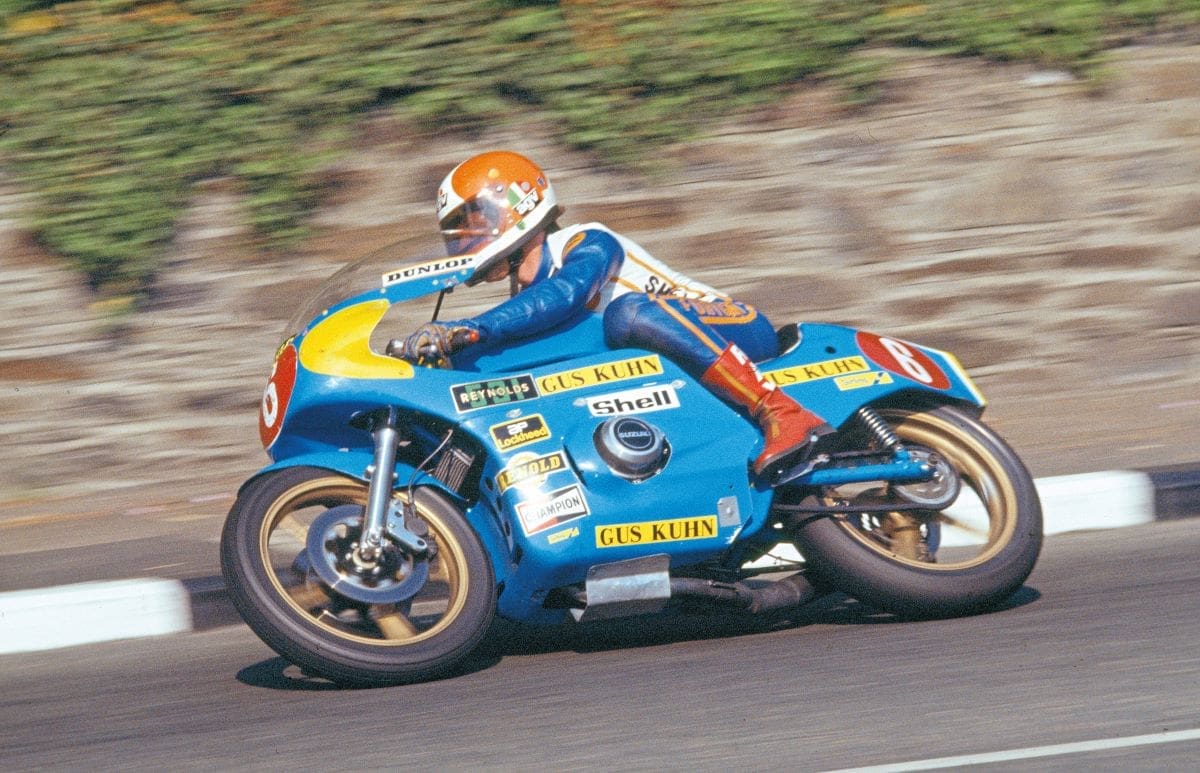
Speedway star Gus Kuhn was born on October 17, 1898, in Birmingham. He was of primarily English descent, though his paternal grandfather was German. He served in both the Royal Naval Volunteer Reserve (RNVR) and the Royal Flying Corps (RFC).
Gus was riding motorcycles long before speedway became a popular sport. In the early 1920s he was riding lightweight Levis motorcycles in trials, hill climbs and scrambles all over the country.
He also enjoyed some success in the Isle of Man TT, riding a Sun in the Lightweight TT of 1922, one of Coventry’s Omega motorcycles in the 1924 Ultra Lightweight TT, and a Velocette and Douglas in the 1925 Junior and Senior TT races. His best finish was fifth in the Junior TT of 1926 on a Velocette.
Gus was a competitor in the first speedway event to take place in Britain at High Beech in 1928. With all of his off-road experience, Gus decided that speedway riding would be a good career move and joined Stamford Bridge, becoming team captain, where he won almost every race he took part in.
Stamford Bridge closed in 1932, and from here he joined the Wimbledon Dons, where he stayed until 1937. In 1932 he had started his own company, Gus Kuhn Motors, in Clapham, with bigger premises acquired postwar.
Gus still competed in the occasional trial or hill climb before ill health caused him to slow down in the late 1950s. He passed away on August 30, 1966, at the age of 67.
Gus Kuhn Motors go racing Nortons
Although the Gus Kuhn Commando is the best-known bike to bear his name, Gus himself had died before the Gus Kuhn Motors race team had success with the mighty twins.
The team had considerable success in the late 1960s and early 1970s – successes that led to the creation of road-going versions of the racer. The team was led by Vincent Davey, who started working at Gus Kuhn’s shop in 1950 and married Marian Kuhn, Gus’s daughter. In 1966, following his father-in-law’s death, Vincent took over the business as managing director.
A visit to the Barcelona 24-hour race in 1968 got his racing juices flowing and Vincent asked the talented young racer Mick Andrew if he would ride for the Gus Kuhn Motors.
Mick’s debut for the team saw him come second at Lydden on a newly-introduced Norton Commando. Vincent sourced some pure racing bikes for the 1969 season, buying an AJS 7R 350 and a Matchless G50 500 from Colin Seeley. A Norton Commando frame was sourced at the same time, and a racing Commando engine was built to go into it.
Mick Andrew came fourth in the 1969 Production TT and won the production race at the Hutchinson 100 at Brands Hatch aboard a Commando. The team’s Seeley G50 with Tom Dickie in the saddle was third in the Senior TT, and he was fourth on the AJS in the Junior race.
By the end of 1969 the Kuhn team was running four Commandos, a fifth Commando-engined Seeley, and the two singles. The success of the Gus Kuhn Commando on the track had been noted by motorcyclists in pursuit of pure speed for the road, and this led to the production of road racers and café racers, as well as the sale of performance parts for the Norton twins. Would-be buyers pored over the glossy catalogue, with the company offering everything from complete bikes and frame kits to racing throttles. The catalogue would eventually offer four complete models – there was a naked Sports café racer, a Street racer with a nose fairing, and a Tourer that went better than it looked, burdened as it was with a large handlebar-mounted touring fairing and a massive five-gallon glass fibre tank. There was a Super Sports model with the same tank, clip-ons, and rear sets but no fairing, and both the Tourer and the Super Sports came with new-fangled disc brakes.
On a winning streak
Meanwhile, the team was sweeping all before it, winning 23 of the 28 races entered during the first season, and when Norton started racing too, the grid at many a meeting became a Norton playground. Despite the way the Kuhn team promoted the brand, it still had to buy racing parts from Norton. The racers were bedecked in the team’s signature Fireflake Green paint scheme.
The Kuhn engines were tuned by Jim Boughen, who’d been employed in the AMC race shop for several years. Kuhn mechanics Frank Kately and Dave Sleat were responsible for building the racers in a cramped corner of the workshop.
The Kuhn machines that the aspiring racer could buy had skimmed, gas-flowed heads and high compression pistons. A factory Norvil Triple S camshaft was fitted, along with specially polished but standard conrods.
After such a successful start for the racing team, a tragic road accident cost Mick Andrew his life. He was working as a mechanic for Gus Kuhn Motors. While testing a Commando on the road outside the shop, he crashed into a car and was killed instantly. He was 24.
Despite the tragedy, the Kuhn team enjoyed a successful 1970 season, with Pat Mahoney and his teammate Barry Sheene racing a Kuhn machine at the Barcelona 24-hour race… until the gearbox broke.
The Gus Kuhn Motors squad was a big supporter of F750 racing when it came to Europe in 1972 and even provided American Daytona 200 winner Don Emde with a Commando for Transatlantic match races. In 1973 it started racing BMWs before going back to Norton for 1974, but with the British motorcycle industry collapsing, Gus Kuhn Motors took on agencies for MV and BMW and eventually became an exclusive BMW dealer. It raced BMWs and in 1978 Chas Mortimer gave the team its swansong – taking a Gus Kuhn Suzuki GS1000 to sixth in the Formula 1 TT won by Mike Hailwood on the Sports Motorcycles Ducati. The team did not return in 1979, and Gus Kuhn Motors itself closed in 1989.
